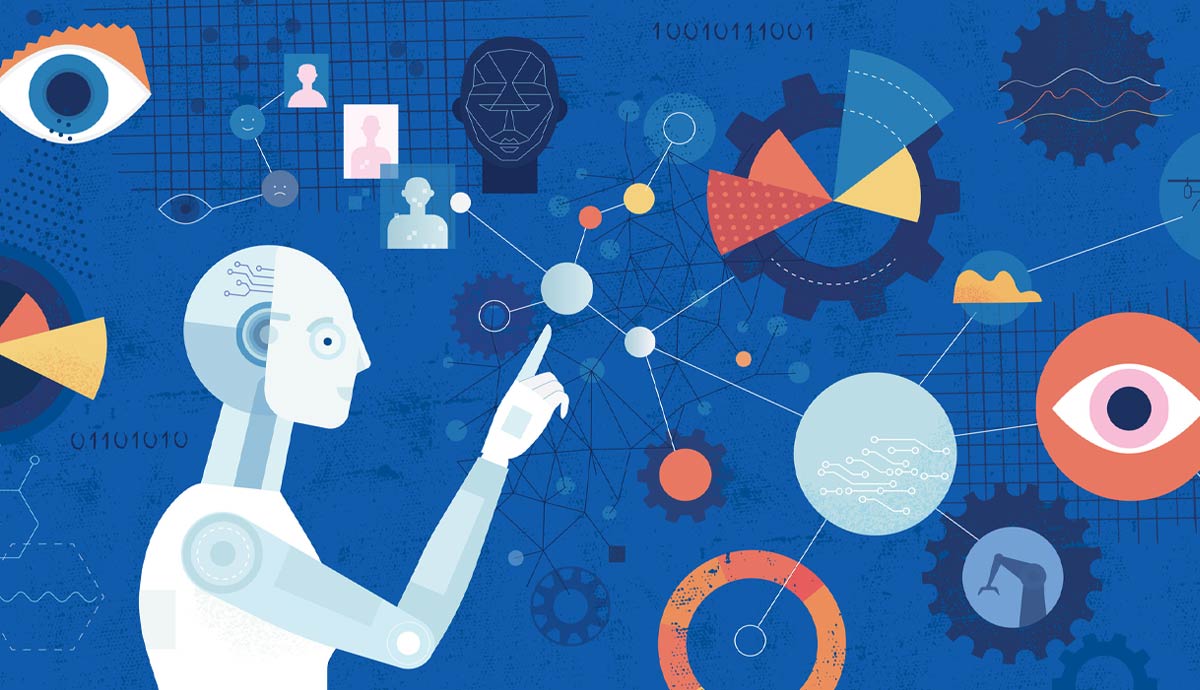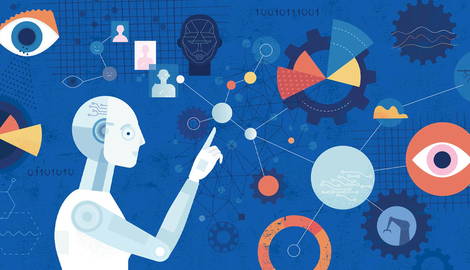
How does life come to be, and how can we replicate and control it? Driven by these types of questions, humans tried to find ways to understand and create one of nature’s biggest marvels. Humankind has always attempted to capture the essence of life by physical replication: statues, paintings, and robots imitate humans. Today, our technology allows us to replicate intelligence and take our quest a step further. This article takes a look at two of the major historical episodes that brought us one step closer to replicating life.
Automata & Artificial Intelligence: Art Imitates Life

One of the earliest mentions of an attempt at creating a life-like being comes from the ancient period. The first such example comes from the story of King Solomon, who supposedly had an automated throne. The throne would have a mechanism that would make statues of animals bow to him and help him ascend the throne whenever he went to sit on it. Similar examples can be found in the legends of Ancient Greece as well.
Hephaestus, the Greek god of blacksmiths, was said to have automated workers that helped him. There is also the legend of Talos, an automaton that was constructed to throw stones at enemies. Probably the best replication of life, as legend goes, was made by the inventor Daedalus, who engineered a moving statue that could speak just like a human. Despite these being all myths, there is some truth to them as research tells us that, indeed, the Ancient Greeks had enough knowledge to build simple automated mechanisms that probably inspired the stories.
Hero of Alexandria (10-70 CE) was an inventor and engineer who built several automated objects. Among the surviving ones, the most popular are the wash basin automaton and Hero’s windwheel. The wash basin automaton would use a system of pipes and water to make the decorative birds around the basin sing whenever the basin was activated, and then the birds would stop singing after the mechanism ended its cycle. The windwheel functioned as a more modern counterpart that used the forces of nature to move.
Automata Becoming Automata

It comes as no surprise that the very nature of the term automaton is rooted etymologically in ancient Greek, meaning something that acts out of one’s willpower. The term was first used by the poet Homer, and its use remained more or less constant throughout the century to describe non-electronic mechanisms that enacted movement. Another particularity of the automata is the fact that, in most cases, it is made to resemble the natural behavior of beings, or as the Greeks put it, willpower itself. The fascination of building and improving such mechanisms was a constant in our history, as the ancient traditions were transmitted in the medieval period. Medieval artisans strived to achieve the accomplishments of Byzantine and their ancient predecessors.
The Renaissance and early modern period brought about a renewed interest in automata because engineering developed beyond the level of mastery it had during the Middle Ages. New discoveries and a better understanding of the Natural world and its laws allowed inventors to capitalize on this knowledge. It was during this period that the sciences got a boost, and intellectuals started to wonder whether there was a way to reach a point of mastery where one could build a perfect robot that replicates the real thing. In the case of humans, this was more complicated due to religious beliefs in the existence of the soul. Intellectuals were hopeful they could replicate an animal perfectly.
Animals as Natural Robots: The Early Modern Automata

The late Renaissance and early modern period are characterized by a worldview influenced by the mechanistic theory. The mechanistic theory posits that the natural world is a big mechanical system that works similarly to a mechanical clock. In this big mechanical world, God is the great engineer of it all, as He ensures that all parts work in perfect harmony. The advancements in anatomy and engineering made intellectuals believe that everything that existed in this world could be likened to a mechanism.
For René Descartes (1596-1650), living organisms are comparable to machines through the virtue of their constitution. Just like machines are put in motion by several parts that work together to create movement and other actions, organisms can also function based on the collaboration of their inner elements that make life possible.
Descartes wrote in the 17th century when there was a fervent interest in anatomy. He is prompted to say that animals are machine-like, comparing them to automata. In his Discourse on method, we are told that there are two ways to ascertain whether a being is a living human or an artificial one, a machine. An automaton could never use speech in a lengthy and discursive manner where one puts one’s thoughts in the external world. Furthermore, it wouldn’t be able to show signs of reason, which can be deduced from its actions.
The Problem With the Human

Despite Descartes’ theory on the living organisms as not that different from machines being very influential in the early modern period, there was still a problem to solve: that of the human. The philosophers of the period struggled with the following question: If indeed the body is constructed like that of a machine, if it is a system, that means that with the necessary technological advancements, it can be replicated. But will these advancements really be enough for us to replicate a human? Is a human just its body?
The main two problems with this were replicating speech and reason. While constructing an automaton of a duck that walked and quacked like one was something that could be done, the same couldn’t be said about a human.
For early modern people, if an automaton had the appearance and behavior of its real and living counterpart, the quest to replicate life was completed. Descartes described an automaton of a duck that even had feathers and replicated the bird’s behavior perfectly in as much as it could be easily mistaken for the real thing.
The advancements of these robots continued well into the 18th and 19th centuries when several human models were constructed in an attempt to overcome the problems of speech and reason. The technological level at the time permitted limited solutions, such as the construction of an automaton that had a pre-setting to write some answers on a paper to give the impression of speech.
The other solution in the case of reason was the production of automata that could beat humans at various games such as chess, although this was oftentimes possible with the intervention or collaboration of another human being who directed the machine, as the automata were not capable of making decisions.
The Rise of Artificial Intelligence

The idea of artificial intelligence only became popular and quite widespread in the 20th century when science fiction pushed the limits of what automata could be. Although our culture was no stranger to the general concept of a robot, as it has existed in one shape or another since ancient times, it was only during this century that the idea of artificial intelligence as we know it came to be.
A very important role in this development was played by polymath Alan Turing, who envisioned how this type of intelligence could function. He observed that humans, when making judgments, make use of readily available information stored inside their minds. Based on this, he wondered why this couldn’t be possible for machines, as well as the fact that the act of storing information is not that special in itself.
In his paper from 1950 entitled “Computing Machinery and Intelligence,” he explained his theory and developed a method to test the intelligence level of artificial intelligence. Turing’s theoretical framework was thus pivotal in establishing the groundwork for creating AI.
Despite his many contributions, Alan Turing didn’t live to see the creation of artificial intelligence, as computers from his time weren’t able to store commands in their memories but could only execute inputted ones. This change in computer technology gave rise to artificial intelligence in practice, beyond theory, paving the way to AI as we know it.
Making Artificial Intelligence Possible

As mentioned, the main obstacle in making artificial intelligence possible was the ability of a computer to store commands and, consequently, execute them. By solving this issue, artificial intelligence would be closer to becoming independent of human input. One of the first programs to mimic the human mind was called the Logic Theorist. This program was funded by the Research and Development (RAND) Corporation and focused on the problem-solving skills of the human mind by using logic commands to help determine the answers of the program to the problems imputed.
From 1957 up to 1974, significant developments were recorded in the world of artificial intelligence. Scientists focused on improving computers so that they are able to store more information and process tasks faster. On the other hand, several programs like the General Problem Solver and ELIZA were developed emphasizing two key elements—namely, the capacity for problem-solving and that of decoding and interpreting language.
Going back to the observations of philosophers like Descartes, it is visible that the AIs of the 20th century emphasized and tried to solve precisely the points that automata failed to replicate—human reason and human speech. From this, it appears that throughout history, there has been a consensus on what makes a human as such found in these two abilities.
Some Thoughts on Automata & Artificial Intelligence Today

From the end of the 20th century until today, artificial intelligence continued to evolve and develop even further, following roughly the same two aims: storing and combining available information in various ways and deciphering human language. Recent developments have been so spectacular that they spark much debate, with many questioning the safety of artificial intelligence for our future.
Many fear the possibility of artificial intelligence developing a mind of its own, becoming independent of us and our input if let to develop too much. This concern is only natural as it seems we are now close to completing the quest that automata began, the pursuit of creating something intelligent in our image.
Although automata have been received throughout our history with enthusiasm and curiosity, the concerns of them potentially becoming too human-like were always there. The existence of automata has fueled philosophers to try to identify what makes a human being. When a creation resembles its maker too closely, discussions about the essence of humankind become a more pressing matter. It is then, maybe more than ever, when we are prompted with the question: what does it mean to be human?
In turn, our inability to give a precise and definitive answer, despite our technological advancements, only contributes to our uneasiness towards the prospects of artificial intelligence.
If we look at artificial intelligence in a historical context from ancient times until now, it appears that this is the most natural development. The quest for building a human-like creature that can operate by itself and imitate the functions of its real counterpart was started a long time ago, during ancient times. Legends, myths, and fiction only prove that we always had this dream of being able to create intelligent life. Only now have we begun to see the results we have wished for since the beginning.










